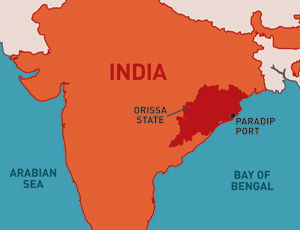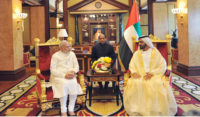
Six years after South Korean steelmaker Pohang Iron and Steel Co. signed a memorandum of understanding with the Orissa government for India’s largest foreign direct-investment project, the $12 billion mega-venture remains a non-starter.
The integrated steel project is mired in opposing political agendas, environmental conflicts and the country’s biggest issue: land acquisition by the government and ongoing protests by local residents who contend the land for the project was taken not for public use but for a private company.
A memorandum of understanding on the 12-million-tons-per-annum integrated steel-plant-and-port project, signed in 2005, reportedly expired last year.
Orissa steel and mines minister Raghunath Mohanty recently announced the government would renew the agreement soon; however, there have been no signs of this happening yet.
“The agreement can never be implemented unless there is shift of the project site,” said opposition leader Niranjan Patnaik of the Orissa Pradesh Congress Committee. The integrated steel project continues to be entangled in opposing political agendas, environmental conflicts and the country’s biggest issue: land acquisition by the government.
Having initially sought 2,025 hectares to build a steel plant and a captive port in Jagatsinghpur, 10 kilometers north of Paradip port, Pohang Iron and Steel Co., or POSCO, settled for 1,620 hectares, or 4,003 acres, to reduce potential displacement.
In works by POSCO India, a subsidiary of POSCO, the plan includes three mines in two districts, for which separate MoUs have yet to be signed. The only movement on the project has been taken by Kolkata-based consulting engineer M.N. Dastur, which completed a report on technical service for a feasibility study as well as a Comprehensive Environmental Impact Assessment and a Rapid Environmental Impact Assessment.
“Construction has not started, and it is likely that there will be no activity for at least seven months,” says an on-site POSCO engineer at Jagatsinghpura, where the steel plant is planned in three stages and will use Finex technology, which can reduce the quantity of iron-ore swapping. Finex allows the direct use of iron-ore and non-coking coal as feedstock and lowers operating costs and emissions compared to the “blast furnace” process. It is known to dramatically reduce construction costs by eliminating the need for sinter and coke plants. It also occupies only 60 percent of the area of the blast-furnace plant it replaces.
POSCO India plans to engage Indian mining engineers and geologists for most of its key positions in developing and operating the captive mines, a company official says. POSCO India is in the process of evaluating options for road and rail transportation infrastructure to move the ore from the mines to the plant; instead of using roads, conveyor belts might be used to access the railway sidings. “People are still awaiting compensation for land given to POSCO. Confidence in the state government is just not there. The anti-POSCO movement does not look like it is waning. People say they are prepared to die to protect their land,” says activist Mahtab Alam.
Mohanty, the Orissa steel and mine minister, faces a difficult road ahead as he facilitates POSCO’s land acquisition. “The government is completely for peaceful industrialization. The district administration is discussing with the people. Though they have encroached on government land, the government is ready to give compensation,” he said.
"We are hopeful and very optimistic about the plant," said Vikas Sharan, POSCO India's vice president.


Post a comment to this article
Report Abusive Comment